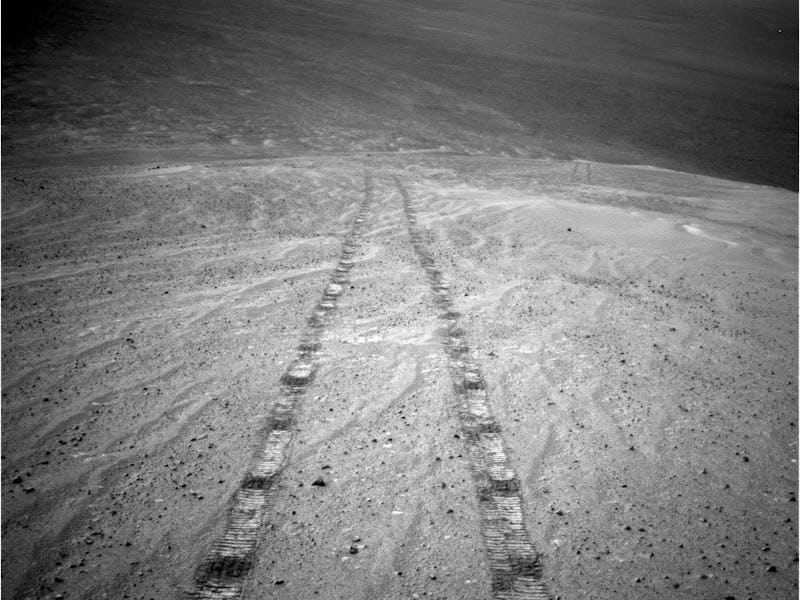On Mars Day, Battered Mars Rover Prepares to Descend Into Water-Carved Valley
It's a proper day to recognize a hardy rover.

Here on Earth, it’s National Mars Day. On Mars itself, the old, dusty Opportunity rover, which was supposed to be dead 13 years ago, stands on the edge of the 14-mile Endeavor Crater, once more about to descend into the unknown.
National Mars Day is recognized annually at the National Air and Space Museum in Washington, D.C., and it’s a chance for visitors to learn about NASA’s extraterrestrial exploration robots, like Opportunity. Before the rover embarks on its next mission, it sent back a panoramic image of the terrain it will soon explore, which is shown in the image below. NASA scientists named this particular “notch” in the crater Perseverance Valley, which could have formed during great flooding events.
“It is a tantalizing scene,” Opportunity Deputy Principal Investigator Ray Arvidson said in a statement. “You can see what appear to be channels lined by boulders, and the putative spillway at the top of Perseverance Valley. We have not ruled out any of the possibilities of water, ice or wind being responsible.”
Opportunity's shot of its next destination, Perseverance Valley, shot with its panoramic camera (Pancam).
The battered Opportunity rover has traveled nearly 28 miles across the rocky Martian terrain over the past 13 years, giving it ample time to shoot images of its looming destination. While that progress might sound slow, the goal is to collect as much data as possible on its journey, which has massively exceeded the original 90-day plan. Not that it’s all been smooth travels: In June, its left front wheel became twisted and stuck at a 30-degree angle, and it took two weeks for NASA engineers to send commands across space and get the rover to set the wheel straight.
Now, Opportunity must wait another two weeks before it can start its journey into the valley. The sun is to blame for the delay, as it will be positioned between Mars and Earth from July 22 to August 1. During this event, called a solar conjunction, NASA won’t send any commands to either of its working rovers, Opportunity and Curiosity, nor to its to orbiting Martian satellites. The sun regularly shoots bursts of charged particles into space, which could interfere with and corrupt the precise commands that NASA transmits to its extraterrestrial robots. For instance, NASA wouldn’t want to inadvertently send a hapless Opportunity tumbling down a steep gorge.
The Opportunity rover
Back on Earth, the Kennedy Space Center Visitor Complex has brought its Batmobile-like Mars Concept Vehicle to the National Air and Space Museum for National Mars Day. Unlike the robotic Opportunity rover, this sleek 400-horsepower, six-wheeled, 28-foot long prototype is meant to provoke ideas about how future NASA astronauts will explore the Martian terrain, long after Opportunty’s historic tracks have disappeared under the red, desert dust.